General Care Tips
Bathing
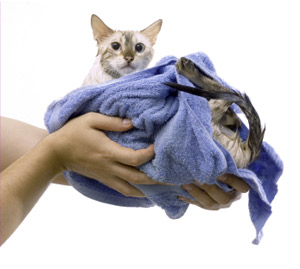
Most of the cats hate water which makes cat washing quite difficult. You can make it as pleasant as possible for your kitty by starting to bathe him/her early in his/his life to get him/her used to the water and to the bathing experience. Since your cat will take care of most of his cleaning needs, you should really only need to bathe him/her once in a while, when he's/she’s really dirty.
When it's time for a bath, place a mat or towel on the bottom of the sink to keep your cat from slipping and make him/her feel more at ease. Run a few inches of lukewarm water into the sink and dampen the cat. Work a small amount of cat shampoo over his/her body, but avoid getting any soap (or water) into his ears, eyes, or nose. Then, thoroughly rinse his/her entire coat with warm water. This is especially important, because your cat will wash him/herself after the bath and will surely lick up any shampoo you missed. After rinsing, wrap him/her in a fluffy towel, dry him/her off, and be sure to keep him/her away from any drafts until he/she is completely dry.
Nail Trimming
An important part of the grooming process is to trim your cat’s nails. They should be trimmed about once a month.
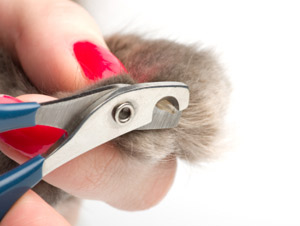
To start trimming, have your cat sit in your lap. While firmly holding him/her in place, gently press down on his/her paw so the nail comes out. Using a pair of cat nail clippers, cut off the tip of each claw, just outside the edge of the pinkish part where the nerves are located. You can learn exactly which part to trim from your veterinarian. If you accidentally cut too deep, the nail will bleed. When this happens, apply light, direct pressure to stop the bleeding. This will likely upset your cat, so the rest of the grooming procedure may have to wait until another day when your cat has calmed down.
Eye Cleaning
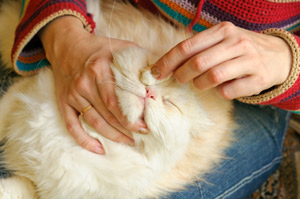
A cat’s eyes require very little attention. If your cat’s eyes are runny or they have residue in the corner, dampen a cotton ball with warm water and gently wipe them clean.
Brushing Teeth
Brushing your cat's teeth should be a regular part of his/her grooming routine. Over time, plaque and tartar will build up on his/her teeth and will need to be removed. So you should start brushing at an early age to get your cat used to it and to avoid extensive build-up.
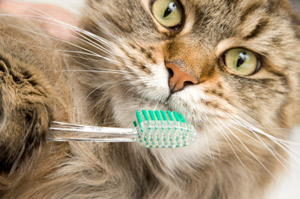
Before beginning to brush, open your cat's mouth and take a careful look at his/her gums and teeth. The gums should appear pink and healthy, and there should be no broken or loose teeth. When you're ready to get started, put a tiny bit of cat toothpaste on a brush and start brushing, one tooth at a time. Only the outer sides of the teeth need to be brushed, because your cat will take care of the insides with his/her rough tongue. Be sure to gently brush the gums.
Taking care of your cat's teeth is important. Neglecting this care can lead to teeth decay and gum disease. You should brush his/her teeth at least once a week, but more often is even better.
Grooming
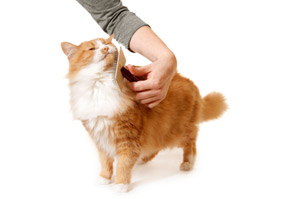
Long Haired Cats
Even though cats are considered "self-groomers," most cats need assistance with their grooming, some more than others. Long-haired cats can have a tough time keeping their long coat looking good, and even some short-haired cats sometimes need a little help. The best way to make grooming your cat as easy a task as possible is to start grooming him/her as a kitten.
There are different grooming requirements for the three types of fur . There are three types:
Long-haired cats (Persian, Himalayan, Ragdoll, etc.) will probably need the most grooming assistance. They have fur that can grow up to twelve centimeters in length and they shed extensively. Their fur can tangled easily and get things can get stuck in it, especially if the cat goes outside often. The best way to avoid significant tangles and excessive shedding is to keep up with the grooming. First, use your fingers to remove tangles from his coat (only use scissors as a last resort). Once all of the knots have been removed, use a brush to smooth the fur in the direction of hair growth.
Short Haired Cats
Short-haired cats (Siamese, Burmese, etc.) have fur that usually measures less than five centimeters in length. Whil the coats of short-haired cats will likely never need significant grooming, it's still a good idea to give the coat a good brush once in a while. First, use a fine-toothed or wide-toothed comb to remove any tangles. Then, use a bristle brush or a soft acrylic brush on the entire coat, brushing in the direction of hair growth. A good brushing will eliminate knots while also removing excess fur.
Hairless Cats
Despite what many people think, there is no such thing as a cat without hair. Hairless cats (Sphynx, etc.) have hair, but their hair is very short and close to the skin, making them appear to be hairless. These breeds require very little grooming.
Ear Cleaning
Cats have very sensitive ears, so handle them gently. About once a week, swab the ear area with a cotton ball dipped in baby oil, removing any dark, waxy residue. Don’t use a cotton swab. You could easily damage his eardrum if he moves and the swab goes deeper into his ear.
You should also be concerned if you see excessive wax, dark residue in his/her ears, or if his/her ears have a bad odor to them. If this is the case, take him/her to the veterinarian as soon as possible. Your veterinarian will be able to diagnose the problem and treat it effectively.